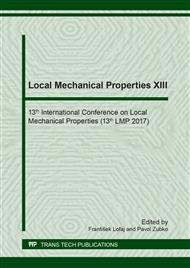[1]
G.D. Wilk, R.M. Wallace, J.M. Anthony, High-κ gate dielectrics: Current status and materials properties considerations, Journal of Applied Physics 89 (2001) 5243-5275.
DOI: 10.1063/1.1361065
Google Scholar
[2]
K.-L. Lin, T.-H. Hou, J. Shieh, J.-H. Lin, C.-T. Chou, Y.-J. Lee, Electrode dependence of filament formation in HfO2 resistive-switching memory, Journal of Applied Physics 109 (2011) 084104.
DOI: 10.1063/1.3567915
Google Scholar
[3]
G. Puzzilli, F. Irrera, Long time transients in hafnium oxide, Microelectronic Engineering 84 (2007) 2394-2397.
DOI: 10.1016/j.mee.2007.04.064
Google Scholar
[4]
E. Bersch, S. Rangan, R.A. Bartynski, E. Garfunkel, E. Vescovo, Band offsets of ultrathin high-κ oxide films with Si, Physical Review B 78 (2008) 085114.
DOI: 10.1103/physrevb.78.085114
Google Scholar
[5]
H. Zhu, C. Tang, L.R.C. Fonseca, R. Ramprasad, Recent progress in ab initio simulations of hafnia-based gate stacks, Journal of Materials Science 47 (2012) 7399-7416.
DOI: 10.1007/s10853-012-6568-y
Google Scholar
[6]
M.F. Al-Kuhaili, Optical properties of hafnium oxide thin films and their application in energy-efficient windows, Optical Materials 27 (2004) 383-387.
DOI: 10.1016/j.optmat.2004.04.014
Google Scholar
[7]
A. Hakeem, M. Ramzan, E. Ahmed, A.M. Rana, N.R. Khalid, N.A. Niaz, et al., Effects of vacuum annealing on surface and optical constants of hafnium oxide thin films, Materials Science in Semiconductor Processing 30 (2015) 98-103.
DOI: 10.1016/j.mssp.2014.09.027
Google Scholar
[8]
M. Al-Kuhaili, S. Durrani, E. Khawaja, Characterization of hafnium oxide thin films prepared by electron beam evaporation, Journal of Physics D: Applied Physics 37 (2004) 1254.
DOI: 10.1088/0022-3727/37/8/015
Google Scholar
[9]
M. Ramzan, M.F. Wasiq, A.M. Rana, S. Ali, M.Y. Nadeem, Characterization of e-beam evaporated hafnium oxide thin films on post thermal annealing, Applied Surface Science 283 (2013) 617-622.
DOI: 10.1016/j.apsusc.2013.07.001
Google Scholar
[10]
M. Gilo, N. Croitoru, Study of HfO 2 films prepared by ion-assisted deposition using a gridless end-hall ion source, Thin Solid Films 350 (1999) 203-208.
DOI: 10.1016/s0040-6090(99)00226-6
Google Scholar
[11]
Z. He, W. Wu, H. Xu, J. Zhang, Y. Tang, The effects of O2/Ar ratio on the structure and properties of hafnium dioxide (HfO2) films, Vacuum 81 (2006) 211-214.
DOI: 10.1016/j.vacuum.2006.02.003
Google Scholar
[12]
M. Ramzan, M.F. Wasiq, A.M. Rana, S. Ali, M.Y. Nadeem, Characterization of e-beam evaporated hafnium oxide thin films on post thermal annealing, Applied Surface Science 283 (2013) 617-622.
DOI: 10.1016/j.apsusc.2013.07.001
Google Scholar
[13]
T. Mori, M. Fujiwara, R.R. Manory, I. Shimizu, T. Tanaka, S. Miyake, HfO2 thin films prepared by ion beam assisted deposition, Surface and Coatings Technology 169-170 (2003) 528-531.
DOI: 10.1016/s0257-8972(03)00189-0
Google Scholar
[14]
D.K. Venkatachalam, J.E. Bradby, M.N. Saleh, S. Ruffell, R.G. Elliman, Nanomechanical properties of sputter-deposited HfO2 and HfxSi1-xO2 thin films, Journal of Applied Physics 110 (2011) 043527.
DOI: 10.1063/1.3627155
Google Scholar
[15]
B.C. He, W.E. Fu, Y.Q. Chang, H.C. Liou, The effect of thickness and loading force on wear behavior of HfO2, Journal of Physics: Conference Series 483 (2014) 012023.
DOI: 10.1088/1742-6596/483/1/012023
Google Scholar
[16]
K. Tapily, J.E. Jakes, D.S. Stone, P. Shrestha, D. Gu, H. Baumgart, et al., Nanoindentation Investigation of HfO2 and Al2O3 Films Grown by Atomic Layer Deposition, Journal of The Electrochemical Society 155 (2008) H545-H551.
DOI: 10.1149/1.2919106
Google Scholar
[17]
W.C. Oliver, G.M. Pharr. An improved techniqu for determining hardness and elastic modulus using load and displacement sensing indentation experiments. 1992. p.20.
DOI: 10.1557/jmr.1992.1564
Google Scholar
[18]
J.E. Lowther, J.K. Dewhurst, J.M. Leger, J. Haines, Relative stability of ZrO2 and HfO2 structural phases, Physical Review B 60 (1999) 14485-14488.
Google Scholar
[19]
M. Modreanu, J. Sancho-Parramon, O. Durand, B. Servet, M. Stchakovsky, C. Eypert, et al., Investigation of thermal annealing effects on microstructural and optical properties of HfO2 thin films, Applied Surface Science 253 (2006) 328-334.
DOI: 10.1016/j.apsusc.2006.06.005
Google Scholar
[20]
R. Saha, W.D. Nix, Effects of the substrate on the determination of thin film mechanical properties by nanoindentation, Acta Materialia 50 (2002) 23-38.
DOI: 10.1016/s1359-6454(01)00328-7
Google Scholar
[21]
T.Y. Tsui, G.M. Pharr, Substrate effects on nanoindentation mechanical property measurement of soft films on hard substrates, Journal of Materials Research 14 (2012) 292-301.
DOI: 10.1557/jmr.1999.0042
Google Scholar


